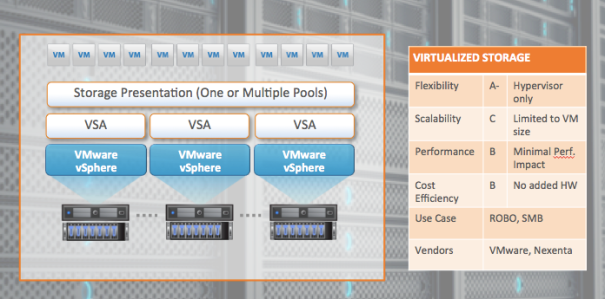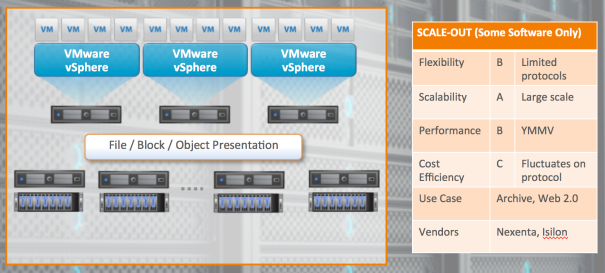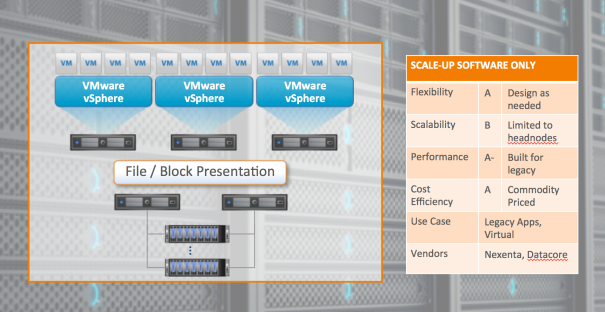Nexenta Blog
Raise Your SDS IQ (5 of 6): Practical Review of Virtual Storage Appliances
21 Jun 2016 by Nexenta
By Michael Letschin, Field CTO
This is the fifth of six posts (the last one was Hyperconverged “SDS”) where we’re going to cover some practical details that help raise your SDS IQ and enable you to select the SDS solution that will deliver Storage on Your Terms. The fifth SDS flavor in our series is Virtual Storage Appliances.
One of the lesser known flavors of SDS is the Virtual Storage Appliance (VSA); it’s less common because it requires a virtual machine environment (think Microsoft’s Hyper-V or VMware), and because there are only a few, software-only options for it (like FreeNAS, LeftHand VSA, or Nexenta’s NexentaStor). There also tend to be feature limitations as a result of the virtual machine environment, such as lack of replication across hosts. That said, for the right use case – such as remote offices, branch offices, small and medium-sized businesses, and multitenant apps – a virtual storage appliance (VSA) can offer a cost-effective storage solution. To use the VMware example, multiple head nodes each connect with vSphere and a VSA to present storage as one or more pools, with data from one or more VSAs.
Virtual storage appliances offer excellent flexibility through the hypervisor, because you can choose which one you’d like. The hypervisor host does confine scalability to VM size, that’s an important limitation. While managing individual VSAs across different hosts can bring some challenges, it also supports flexibility. You can spin up VSAs per group or per application to create multitenancy using VSAs. IT maintains control, even though individual teams might think they’re managing their storage pools. This approach offers good performance: even a loaded hypervisor only has minimal impact. And finally, this model doesn’t require any additional hardware, so there’s a nice cost benefit.
Overall grade: C
See below for a typical build and the report card:

Raise Your SDS IQ (4 of 6): Practical Review of Hyperconverged “SDS”
14 Jun 2016 by Nexenta
by Michael Letschin, Field CTO
This is the fourth of six posts (the last one was Scale-out) where we’re going to cover some practical details that help raise your SDS IQ and enable you to select the SDS solution that will deliver Storage on Your Terms. The fourth SDS flavor in our series is Hyperconverged “SDS”.
Hyperconverged systems are the subject of much industry hype and analyst debate. Some consider hyperconverged systems to be a form of SDS, others keep them out of the category for not having software-only options. What to know: a hyperconverged system is a single integrated hardware and software system comprising multiple head nodes that present all storage as one virtual pool (think Nutanix or VMware’s EVO Rail). This means that some of the software-only SDS benefits – like flexibility and cost effectiveness – are severely limited.
That said, because it’s fast and easy to set up and drop in a hyperconverged system, it’s a good choice for branch offices or green-field deployments, where there are no existing storage systems to integrate with. Hyperconverged systems are somewhat of a “black box”– meaning you’re not going to have access to software to tune – but you can dial up the performance by increasing the number of nodes.
The downside of Hyperconverged “SDS” is that it’s difficult to impossible to change the system later. Hyperconverged “SDS” provides building block only. You buy what the vendor is selling, which narrows your options. Because you’re tied to a vendor and their pricing models, cost efficiency is also limited. Plus, you’ll need to buy equal amounts of storage and compute capacity. Unless you’re an organization where requirements for storage and compute capacity scale in perfect step, this means you’ll end up with too much of one or the other, wasting part of your investment.
Overall grade: C
See below for a typical build and the report card:

Raise Your SDS IQ (3 of 6): Practical Review of Scale-out
07 Jun 2016 by Nexenta
This is the third of six posts (the last one was Scale-up Software-Only “SDS”) where we’re going to cover some practical details that help raise your SDS IQ and enable you to select the SDS solution that will deliver Storage on Your Terms. The third SDS flavor in our series is Scale-out.
Scale-out is a fundamentally different approach from scale-up; with Scale-out, multiple head nodes can be attached over the network to dramatically increase scalability. This is a broad category, and solutions for it could be either vendor-defined / hardware based (think EMC’s Isilon), or software-only (Nexenta’s NexentaEdge); while we’d consider the software-only approach to be the SDS version, the technical benefits of either type of scale out are similar. You use low-latency networking to connect as many nodes as you want and form a cluster that provides storage services out to applications as unified name space.
The scale-out approach works well for Archive or Web 2.0 applications use cases. Scalability is top notch, because you can start small and grow just by adding nodes. While it provides the performance needed to handle huge capacities, there’s an important dependence on the network – the quality of your gear will significantly impact performance, because of the amount of communication between nodes; that may mean that your IOPS aren’t great
The flexibility of scale-out SDS is generally good but currently offers limited protocol support. Often the maturity of the platforms themselves limits your flexibility; for example, you can’t use Exchange to write to an object back end. Likewise, object-oriented applications won’t work with some back ends, either. Protocol support considerations also impact the cost effectiveness of Scale-out: they may restrict your hardware choices and lock you in to more expensive purchases.
Overall grade: B
See below for a typical build and the report card:

Lenovo Selects Nexenta for Lenovo StorSelect Program; Introduces Joint OpenSDS-Based Enterprise Storage Solution
06 Jun 2016 by Nexenta
Earlier today, you may have heard about Lenovo’s StorSelect Program, which allows customers to confidently deploy new storage technologies using pre-loaded appliances with software from best-of-breed, Independent Software Vendors (ISVs) on proven Lenovo systems. The StorSelect solutions enable easy expansion for scalable deployments, as well as integration with existing storage infrastructures. The program will also offer quality, engineering expertise and access to Lenovo’s worldwide global services.
In March 2016, we announced our partnership with Lenovo as part of this program with a shared initiative to drive broader adoption of next-generation software storage solutions. We introduced a joint solution that integrates our award-winning, software-defined storage (SDS) with Lenovo x86 servers: The Lenovo Storage DX8200N powered by NexentaStor.
The Lenovo Storage DX8200N powered by NexentaStor allows you to accelerate and simplify unified file and block storage deployments. At the same time, this pre-validated turnkey solution provides easy scalability and simplified management at a fraction of the cost of legacy systems—without trade-offs in availability, reliability or functionality.
The integrated solutions will offer Lenovo customers worldwide, both scale-up and scale-out reference architectures on all flash, hybrid and spinning media systems. These solutions with Lenovo’s industry leading service and support will deliver a new SDS standard.
Target use cases for the Lenovo Storage DX8200N powered by NexentaStor solution include:
- Unified File (NFS and SMB) and Block (Fibre Channel and iSCSI) services
- VMware cloud backend storage
- OpenStack and CloudStack backend storage
- Generic NAS file services and Home Directory storage
- Near-line archive and large scale backup repositories
“Lenovo recognizes Software-Defined Storage as the strategic storage solution to deliver revolutionary economics for enterprise and cloud storage needs,” said David Lincoln, General Manager of the Storage Business Unit at Lenovo. “We have selected Nexenta as a key partner for our StorSelect Program and are leveraging Nexenta’s deep storage software R&D skills and Lenovo’s proven enterprise servers to deliver an innovative, trusted, and scalable enterprise storage solution. Lenovo Storage DX8200N powered by NexentaStor will give customers the freedom to scale their data to meet business needs today and tomorrow.”
While pricing will vary on capacity and media types, you can expect affordable cents per gigabyte pricing for complete systems including three years of technical support.
Additional Resources:
Lenovo Storage DX8200N powered by NexentaStor data sheet
Lenovo StorSelect analyst paper
If you’re planning to attend Lenovo’s Tech World conference on June 9, 2016 in San Francisco, please visit the Data Center Group showcase at the Fairmont to see demos of the new Lenovo Storage DX8200N powered by NexentaStor solution.
Raise Your SDS IQ (2 of 6): Practical Review of Scale-Up Software-Only SDS
24 May 2016 by Nexenta
by Michael Letschin, Field CTO
This is the second of six posts (the last one was Scale-up Vendor-Defined “SDS”) where we’re going to cover some practical details that help raise your SDS IQ and enable you to select the SDS solution that will deliver Storage on Your Terms. The second SDS flavor in our series is Scale-up Software-Only SDS.
Scale-up Software-Only SDS is just that – SDS benefits delivered via a software-only approach; the software sits on industry standard servers (think Cisco, Dell, Supermicro) and can leverage a variety of JBODs (like Fujitsu, Supermicro, Quanta). The end result is similar to what you get with Scale-up Vendor-Defined “SDS” — one or two commodity head nodes with JBOD behind it – but with two big differences: much better cost efficiency because it’s more vendor agnostic, and greater opportunity for scale up by leveraging big disks for the JBODs (like Supermicro’s 90-bay). Both provide REST-based management with rich APIs via front-end software, to enable easy, automatic provisioning and management of storage. Unlike Vendor-Defined, Scale-up Software-Only SDS offers good scalability and excellent cost efficiency and flexibility because of it’s software-only approach.
Scale-up Software-Only SDS is an excellent option for companies running virtual machines or the legacy apps that help run their business. It’s a good choice if you have accounting applications and legacy hardware because its performance in this use case is excellent. Unlike vendor-defined options, this one gives you the flexibility to design your solution as needed; and that applies both to the solution you need today, as well as creating flexibility for the future.. Plus, you can choose the most cost-effective commodity-priced machines rather than paying a premium for proprietary hardware – we’ve seen as much as 50-80% cost difference between identical solutions of the different types. Scale-up Software-Only SDS is limited to one or two head nodes, but you can put larger drives behind them, so you can scale up pretty big, but obviously scale out is limited.
Overall grade: A-
See below for a typical build and the report card:

